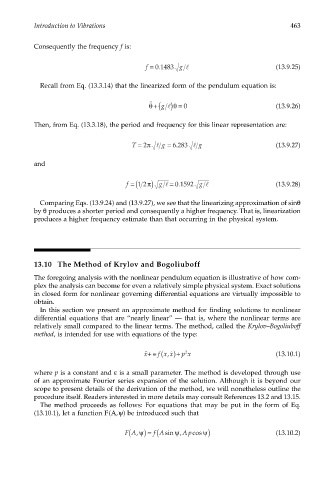Page 482 - Dynamics of Mechanical Systems
P. 482
0593_C13_fm Page 463 Monday, May 6, 2002 3:21 PM
Introduction to Vibrations 463
Consequently the frequency f is:
f = 0 1483 g l (13.9.25)
.
Recall from Eq. (13.3.14) that the linearized form of the pendulum equation is:
˙˙ g l θ (13.9.26)
θ +( ) = 0
Then, from Eq. (13.3.18), the period and frequency for this linear representation are:
T = 2π l g = 6 283 l g (13.9.27)
.
and
f = (1 2π ) g l = 0 1592 g l (13.9.28)
.
Comparing Eqs. (13.9.24) and (13.9.27), we see that the linearizing approximation of sinθ
by θ produces a shorter period and consequently a higher frequency. That is, linearization
produces a higher frequency estimate than that occurring in the physical system.
13.10 The Method of Krylov and Bogoliuboff
The foregoing analysis with the nonlinear pendulum equation is illustrative of how com-
plex the analysis can become for even a relatively simple physical system. Exact solutions
in closed form for nonlinear governing differential equations are virtually impossible to
obtain.
In this section we present an approximate method for finding solutions to nonlinear
differential equations that are “nearly linear” — that is, where the nonlinear terms are
relatively small compared to the linear terms. The method, called the Krylov–Bogoliuboff
method, is intended for use with equations of the type:
˙˙ x+∈ ( , ˙ x)+ p x (13.10.1)
2
f x
where p is a constant and ε is a small parameter. The method is developed through use
of an approximate Fourier series expansion of the solution. Although it is beyond our
scope to present details of the derivation of the method, we will nonetheless outline the
procedure itself. Readers interested in more details may consult References 13.2 and 13.15.
The method proceeds as follows: For equations that may be put in the form of Eq.
(13.10.1), let a function F(A,ψ) be introduced such that
FA,ψ) = ( ψ Apcosψ) (13.10.2)
(
f Asin ,

